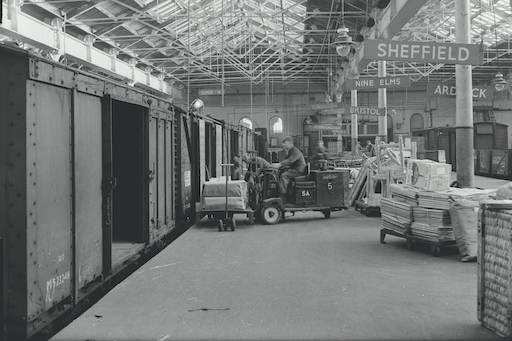
Station Hall
York's Former Goods Station

Loading freight onto wagons at York Goods Station, 1961. Science Museum Group. Image no. E2008.170.1_1368.
When we think of the railways, we tend to think of our passenger services: of day trips away to the seaside, of commuters on their way to work, of the hustle and bustle of station platforms. But this risks overlooking one of the most essential and lucrative roles of the railway, the transportation of goods.
We currently find ourselves in one of Britain’s best-preserved former goods stations, the perfect place to tell our story. From 1877 to 1972, this building was a hive of activity, filled with the noise of shunting trains, rumbling carts and members of staff trying to communicate with one another over the top of it all.
It’s remarkable just how similar the site looks now when compared to photographs taken when the building was fully operational. Look at the image on your phone, for example. Taken in the early 1950s, we can see a member of station staff loading goods onto a line of wagons, located directly in front of where we are right now. In fact, if we were here at the time this image was taken, we’d be surrounded at all sides by carts full of freight.
Another thing we’d notice as we investigate the site, would’ve been the peculiar smells emanating from various items around us. Railway companies were ‘common carriers’, which meant they were required by law to transport anything and everything so long as it could fit on their trains. Imagine the peaceful Station Hall we find ourselves in, packed with pungent foodstuffs like vegetables and spilt vinegar, with chemical odours coming from tins of paint and the smell of straw packed round everything to keep it secure.
Goods stations like this were trailblazers in the transportation industry, ensuring produce could be moved quickly and cheaply to all corners of the country for the first time. Today, our economy relies on large distribution warehouses transporting goods in a very similar way to the method adopted by York’s goods station back in 1877. A clear indicator that the goods trade was essential to the success of Britain’s railways.